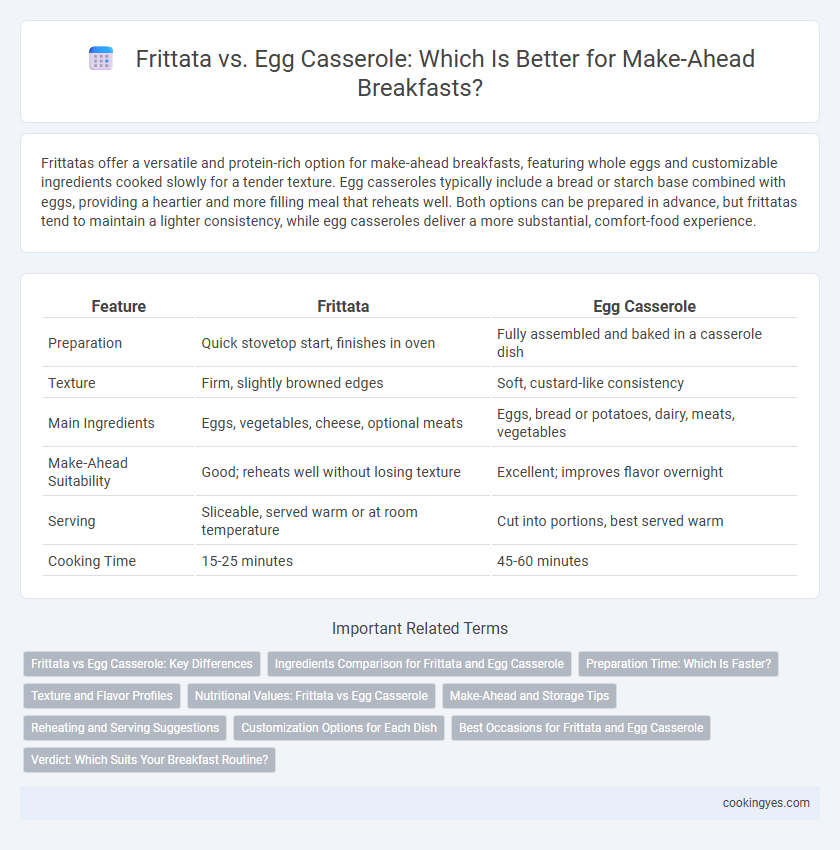Frittatas offer a versatile and protein-rich option for make-ahead breakfasts, featuring whole eggs and customizable ingredients cooked slowly for a tender texture. Egg casseroles typically include a bread or starch base combined with eggs, providing a heartier and more filling meal that reheats well. Both options can be prepared in advance, but frittatas tend to maintain a lighter consistency, while egg casseroles deliver a more substantial, comfort-food experience.
Table of Comparison
| Feature | Frittata | Egg Casserole |
|---|---|---|
| Preparation | Quick stovetop start, finishes in oven | Fully assembled and baked in a casserole dish |
| Texture | Firm, slightly browned edges | Soft, custard-like consistency |
| Main Ingredients | Eggs, vegetables, cheese, optional meats | Eggs, bread or potatoes, dairy, meats, vegetables |
| Make-Ahead Suitability | Good; reheats well without losing texture | Excellent; improves flavor overnight |
| Serving | Sliceable, served warm or at room temperature | Cut into portions, best served warm |
| Cooking Time | 15-25 minutes | 45-60 minutes |
Frittata vs Egg Casserole: Key Differences
Frittatas are Italian-style egg dishes cooked slowly on the stovetop and finished in the oven, resulting in a dense, custard-like texture without added bread or layers, unlike egg casseroles which typically include bread or potatoes and are baked entirely in the oven. Frittatas cook faster and reheat well, making them ideal for individual servings and easier portion control for make-ahead breakfasts. Egg casseroles tend to be heavier, with a fluffier texture due to baking and added ingredients, providing a heartier but less versatile option compared to frittatas.
Ingredients Comparison for Frittata and Egg Casserole
Frittatas typically feature whole eggs combined with a variety of vegetables, cheeses, and meats, relying on less dairy and no added liquid, resulting in a dense, open-faced dish. Egg casseroles generally include eggs mixed with milk or cream, more cheese, and bread or hash browns, creating a richer and more custard-like texture suitable for batch baking. The simplicity of frittata ingredients supports quick preparation and lighter textures, while casseroles offer heartier, cream-based compositions ideal for make-ahead breakfasts.
Preparation Time: Which Is Faster?
Frittatas typically require less preparation time compared to egg casseroles, as they are cooked on the stovetop or baked quickly in an oven without needing to bake a layered dish. Egg casseroles often involve more ingredients and steps like layering, mixing, and pre-baking components, which extends the overall preparation time. For busy mornings, frittatas offer a faster make-ahead breakfast option, balancing convenience with flavor and nutrition.
Texture and Flavor Profiles
Frittatas offer a firm yet tender texture with a rich, creamy custard base that highlights individual ingredients like vegetables and cheeses, creating distinct flavor bursts in each bite. Egg casseroles tend to be softer and more uniform in texture, often enhanced with bread or hash browns for added density and a heartier mouthfeel. Flavor profiles in frittatas are typically more pronounced and fresh due to quicker cooking methods, while egg casseroles develop deeper, melded flavors from longer baking and the incorporation of multiple layers.
Nutritional Values: Frittata vs Egg Casserole
Frittatas typically offer higher protein content per serving due to their egg-to-ingredient ratio, providing a nutrient-dense option for make-ahead breakfasts. Egg casseroles often include added ingredients like bread or potatoes, increasing carbohydrate content and calories while potentially diluting protein concentration. Choosing between the two depends on dietary goals, with frittatas favoring higher protein and lower carbs, whereas egg casseroles may deliver more varied macro- and micronutrients depending on mix-ins.
Make-Ahead and Storage Tips
Frittatas are ideal for make-ahead breakfasts due to their firm texture, which holds up well when refrigerated and reheated without becoming soggy. Egg casseroles often contain more dairy and bread, making them prone to becoming watery or mushy upon storage. To optimize freshness, store frittatas in an airtight container and reheat gently in the oven to preserve their flavor and texture.
Reheating and Serving Suggestions
Frittatas reheat evenly without losing their creamy texture, making them ideal for quick make-ahead breakfasts, while egg casseroles can sometimes become soggy or rubbery when reheated. Slice frittatas into individual wedges to serve warm with fresh herbs or a side salad, enhancing their rich, egg-based flavor. In contrast, egg casseroles pair well with crispy toppings or melted cheese added after reheating to restore their texture and flavor.
Customization Options for Each Dish
Frittatas offer extensive customization options with endless combinations of vegetables, cheeses, herbs, and meats, allowing personalized flavors and textures without altering the cooking time. Egg casseroles provide a similarly versatile base but often include bread or potatoes for added substance, making them ideal for layering distinct flavors and ingredients that meld together during baking. Both dishes support diverse dietary needs through ingredient swaps, but frittatas excel in quick adjustments and portion control, while casseroles shine in batch preparation and heartier servings.
Best Occasions for Frittata and Egg Casserole
Frittatas are ideal for brunches and small gatherings due to their elegant presentation and ease of individual serving, while egg casseroles excel at feeding larger groups, making them suitable for holiday breakfasts or weekend family meals. The frittata's stovetop-to-oven method allows for versatile ingredient layering, perfect for showcasing fresh vegetables and herbs. Egg casseroles benefit from their overnight baking, which enhances flavors and provides a hearty, sliceable dish ideal for make-ahead convenience.
Verdict: Which Suits Your Breakfast Routine?
Frittatas offer a versatile, protein-rich option that cooks quickly and holds well for individual servings, ideal for those seeking a light yet satisfying make-ahead breakfast. Egg casseroles provide a heartier, more filling meal with added ingredients like cheese, vegetables, and bread, perfect for feeding larger groups or those wanting a substantial start to the day. Choose frittatas for speed and portion control, while egg casseroles suit family-style meals with varied textures and flavors.
Frittata vs Egg Casserole for make-ahead breakfasts Infographic

 cookingyes.com
cookingyes.com